Today's post, the first of the New Year, deals with the last three commemorative issues of 1972. This group includes the first se-tenant issue consisting of 4 designs, since the 1970 Christmas issue and also the only issue to exist with both the new obsolete Winnipeg Tagging and the newer OP-2 Ottawa tagging. Finally, this group includes the Cornelius Krieghoff issue, which boasts one of the largest range of constant varieties of any modern stamp, with Unitrade noting that there are at least 24 constant varieties recorded.
Ashton Potter printed all but one of these issues, with the Krieghoff issue being printed by an affiliate of the BABN, called Saults & Potter Ltd, a firm located in Winnipeg. This issue was the last commemorative issue to be printed both with and without tagging: all commemorative issues after this were regularly issued with tagging only. These issues were also the first group to be comb perforated only. However, as noted further in this post, four gauges are noted, although they do not appear to exhibit any real variation, so that the complication that existed in the prior period of the 1960's to early 1972 has now officially come to an end. This group also introduces a new issuing format: the mini-pane of 16 stamps. The Earth Sciences issue was printed in sheets of 128 stamps that were arranged in small sheets of 16 stamps, which were guillotined apart. This was also the first group of commemoratives to be produced entirely by lithography.
As always, this post will introduce the basic designs, give information about issue quantities and designers, before launching into a detailed discussion of all the physical aspects to the stamps.
The Stamp Designs, Issue Dates, Quantities, Designers and Printers
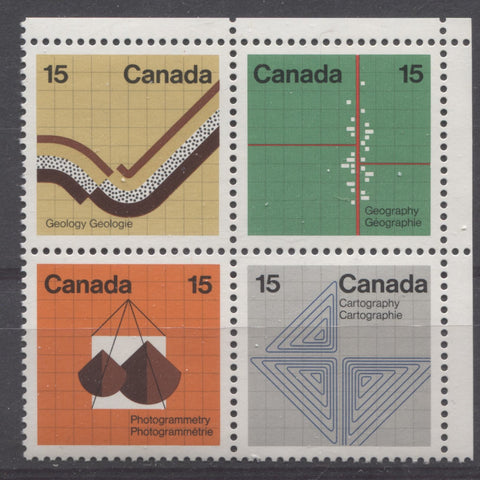
15c multicoloured - Earth Science Issue
From upper left clockwise: Geology, Geography, Photogrammetry and Cartography
Issued: August 2, 1972
Issue Quantity: 4,400,000 of each, including tagged and untagged.
Designed by: Fritz Gottschalk
Printed by Ashton Potter using Lithography

6c red and multicoloured - Christmas issue, depicting candles
Issued: November 1, 1972
Issue Quantity: 127,839,000 including untagged, Winnipeg tagged and Ottawa tagged
Designed by: Ray Webber
Printed by Ashton Potter using 4 colour lithography.
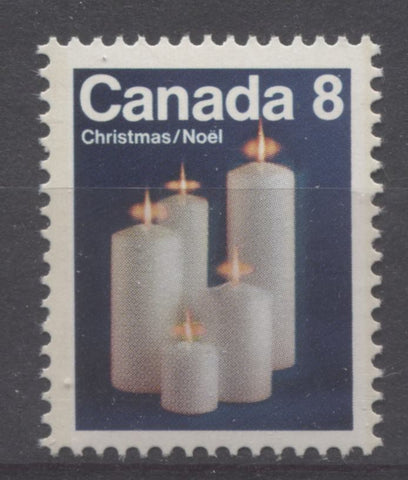
8c blue and multicoloured - Christmas issue, depicting candles
Issued: November 1, 1972
Issue Quantity: 80,025,000 including untagged, Winnipeg tagged and Ottawa tagged
Designed by: Ray Webber
Printed by Ashton Potter using 4 colour lithography.
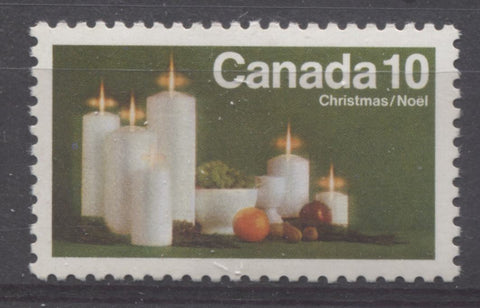
10c green and multicoloured - Christmas issue, depicting candles and fruit
Issued: November 1, 1972
Issue Quantity: 11,400,000 including untagged, Winnipeg tagged and Ottawa tagged
Designed by: Ray Webber
Printed by Ashton Potter using 4 colour lithography.
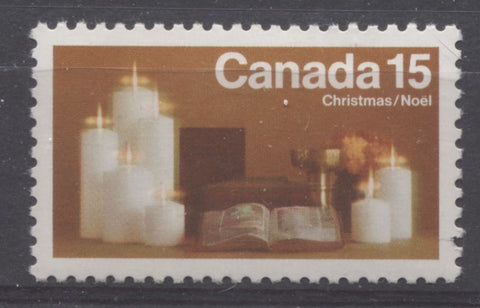
15c yellow bistre and multicoloured - Christmas issue, depicting candles and fruit
Issued: November 1, 1972
Issue Quantity: 16,688,000 including untagged, Winnipeg tagged and Ottawa tagged
Designed by: Ray Webber
Printed by Ashton Potter using 4 colour lithography.
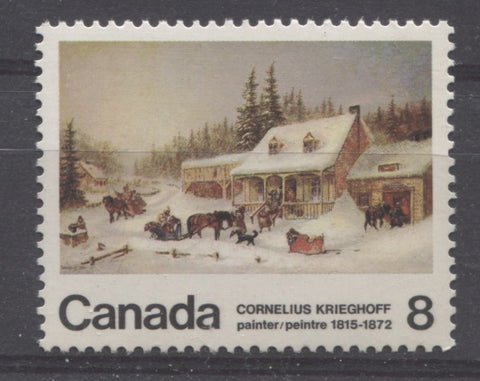
8c multicoloured - The Blacksmith's Shop, by Cornelius Krieghoff
Issued: November 29, 1972
Issue Quantity: 29,600,000 including tagged and untagged
Designed by: William Rueter
Printed by: Saults & Pollard Ltd. using 4 colour lithography
Paper Characteristics Other Than Fluorescence
As has been the case with the issues of 1968-1972, the stamps of the last few months of 1972 exhibit some significant variations in the attribute of the paper, other than fluorescence:
- A thick, light cream coloured, horizontal wove paper, with no distinct mesh pattern, even when held up to strong backlighting. The printing surface is covered by a smooth chalk coating that shows no pores, and has an eggshell sheen. This paper is found on the Earth Sciences Issue.
- A medium, white vertical wove paper that shows distinct horizontal ribbing on the printing surface. There is no visible mesh pattern visible when held up to light though. The printing surface is coated in a smooth, chalky coating, which is ribbed, but which has an eggshell sheen. The inked surface of the paper has a semi-gloss sheen. This paper is found on the Christmas issue.
- A slightly thicker, white vertical wove paper that shows very weak to no visible ribbing and a similar chalk coating to #2 above, except that it appears smooth. The inked surface is duller, giving off a satin sheen. This paper is also found on some printings of the Christmas issue.
- A similar paper to #3 above, but the colour is distinctly cream rather than white. This paper is found on some printings of the Christmas issue.
- A thinner, white vertical wove paper that shows no distinct mesh pattern, even when held up to a strong backlight. This paper has a smooth chalk coating on the printing surface that gives an eggshell sheen. The majority of the Kreighoff stamps are found on this paper.
- A thicker, deep cream vertical wove paper, that is otherwise similar to #5 above. A small portion of the Kreighoff stamps were printed on this paper.
The scan below shows the difference between the white paper and the cream paper on two blocks of the 6c Christmas stamp, as seen from the back:
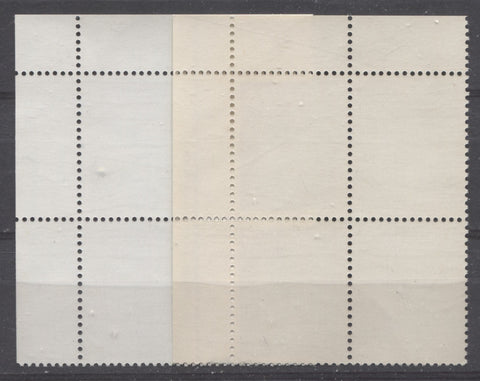
The normal white paper is shown on the left, while the cream paper is shown on the right. As you can see, the difference is quite striking. The paper appears different under UV light also, as we shall see in the next section.
The difference between the two papers used for the Kreighoff stamp is shown below:
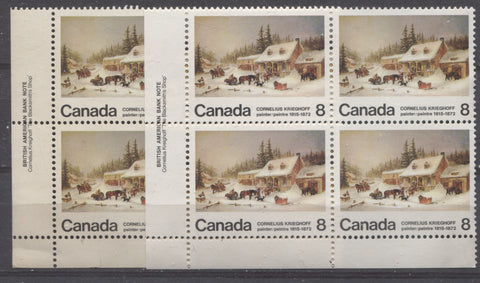
The deep cream paper is shown in the block on the left, while the white paper is on the right.
Paper Fluorescence
Generally speaking, these issues are all thought of by philatelists as being printed on highbrite paper. However, all of them do exhibit variations, on both the front and back that range from true hibrite to dull fluorescent. Also, many of the papers contain concentrations of brownish woodpulp fibres, that have the effect of toning down the perceived fluorescence from where it would otherwise be.
The Earth Sciences Issue
This issue is found with three levels of fluorescence on the front of the stamps: high, medium and low fluorescence. On the back, the fluorescence varies from medium to low fluorescence, with the paper containing a sparse concentration of brownish woodpulp fibres. The main differences in the appearance of the papers on this issue is shown in the pictures below:
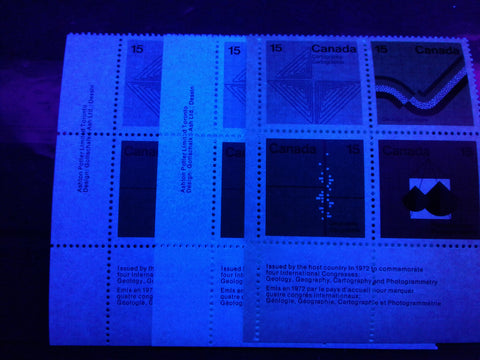
Here, the high fluorescent paper is shown in the middle, the low fluorescent paper is on the right, and the medium fluorescent paper is shown on the left.

This picture shows the medium and low fluorescent papers on the back of the stamps. The low fluorescent paper is shown in the block at left, while the medium fluorescent paper is shown on the right. The low fluorescent paper is actually dull fluorescent, and contain a medium density concentration of low fluorescent fibres, very sparse concentrations of high fluorescent and hibrite fibres, and a sparse concentration of brownish woodpulp fibres. The medium fluorescent paper is actually low fluorescent, with a medium density concentration of medium fluorescent fibres, a very sparse concentration of hibrite fibres and a sparse concentration of brownish woodpulp fibres.
The Christmas Issue
I have found four distinct varieties of fluorescence on the front of these stamps as well as the back. On the front, the stamps can appear to have:
- A high fluorescent appearance, which is mottled.
- A high fluorescent appearance, which is even, and shows the ribbing in the paper.
- A low fluorescent appearance, which is mottled, and
- A low fluorescent appearance which is even, and shows the ribbing in the paper.
The pictures below show these differences on the front of the 6c value of this set:
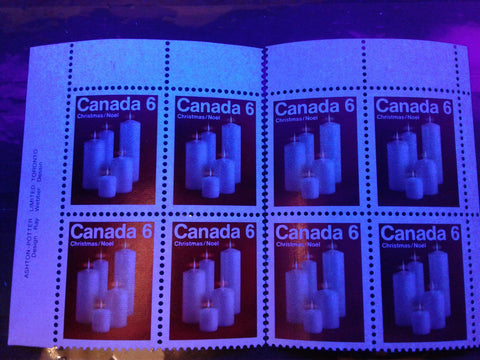
The above two blocks show the second and fourth types, discussed above. The high fluorescent paper is on the left, while the low fluorescent paper is on the right. Note that the fluorescence appears even over the whole block.
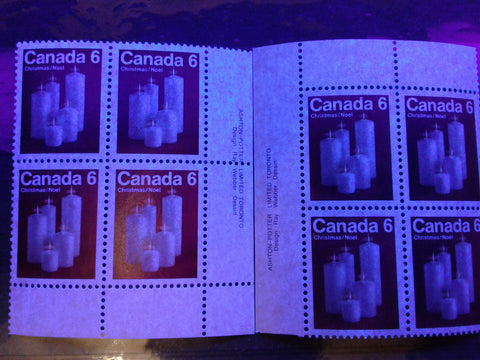
Here we have the mottled fluorescence. The high fluorescent paper is shown on the left, while the low fluorescent paper is on the right.
On the back, we also have four varieties. Two of these are high fluorescent and very close to one another:
- A high fluorescent paper that contains a low density concentration of high fluorescent fibres, a sparse concentration of brownish woodpulp fibres and a very sparse concentration of hibrite fibres.
- An almost identical paper that is just a little less bright, but is still high fluorescent.
- A medium fluorescent paper that contains a low density concentration of of medium fluorescent fibres, and a very sparse concentration of brownish woodpulp fibres.
- A low fluorescent paper that contains a low density concentration of low fluorescent fibres, and a very sparse concentration of brownish woodpulp fibres.
The picture below shows these differences as seen from the back of four blocks:
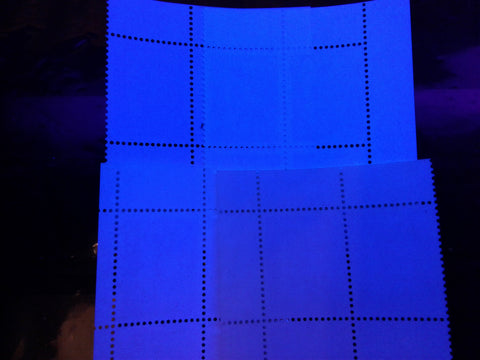
The top two blocks are the high fluorescent paper, while the bottom left block is the medium fluorescent paper and the bottom right block is the low fluorescent paper.
The question then arises as to which combinations of front and back fluorescence exist? The following are the combinations that I found on the 6c, which is the most widely printed of the four values:
- Mottled low fluorescent on front, high fluorescent type 1 on back.
- Mottled high fluorescence on front, high fluorescence type 1 on back.
- Mottled low fluorescence on front, high fluorescence type 2 on back.
- High fluorescence on front, high fluorescence type 2 on back.
- Mottled low fluorescence on front, medium fluorescence on back.
- Mottled low fluorescence on front, low fluorescence on back.
- High fluorescence on front, medium fluorescence on back.
- Low fluorescence on front, medium fluorescence on back (cream paper).
I would expect that these combinations and possibly more should exist for all four values in the set.
The Cornelius Krieghoff Stamp
This stamp exists with all five major levels of fluorescence on the front: hibrite, high fluorescent, medium fluorescent, low fluorescent and dull. On the back, I have found three levels of fluorescence: dull flecked, medium fluorescent and high fluorescent. Without a doubt, the majority of stamps are hibrite on the front and high fluorescent on the back. The scarcest stamps are those with high fluorescent front and dull fluorescent flecked back, and the low fluorescent and dull fluorescent front stamps.
The following pictures show the differences on the front and back of various blocks of this stamp:
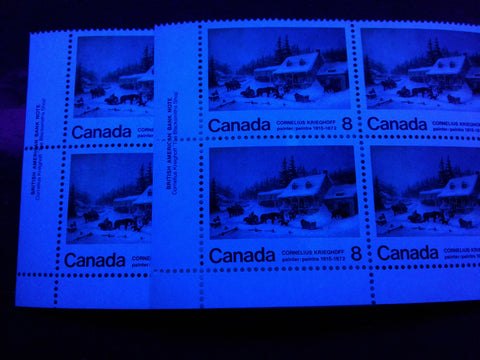
Here we have the true hibrite paper on the left, and the high fluorescent paper in the right.
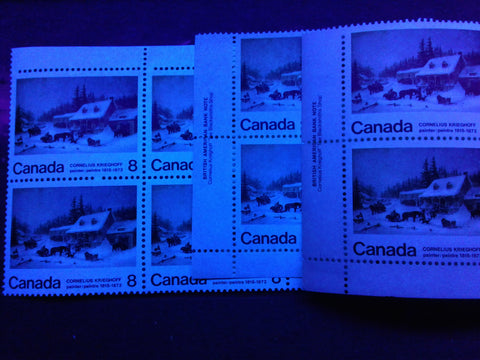
The block on the left is the medium fluorescent paper, while the middle block os low fluorescent and the right block is dull fluorescent. The medium fluorescent paper looks brighter here than the two blocks in the last picture, but only because it has been placed next to the low and dull fluorescent blocks.
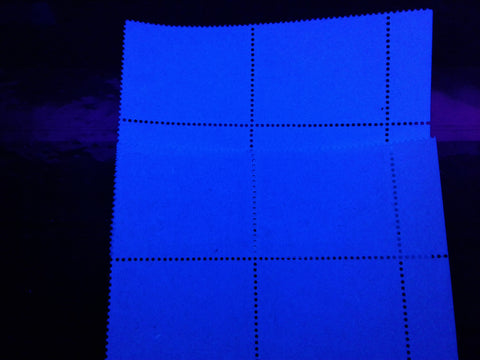
Here are the high and low fluorescent papers, as seen on two blocks taken from the back. The difference here looks only slight, but it is quite pronounced. The high fluorescent paper contains a low density concentration of high fluorescent fibres and a sparse concentration of brownish woodpulp fibres. The medium fluorescent paper is similar, except that the fluorescence level of the paper and fibres is medium fluorescent, rather than high fluorescent.

In this picture we see the dull fluorescent flecked paper contrasted to the medium fluorescent paper that was shown above. The dull fluorescent paper is deep grey, with a low density concentration of low fluorescent fibres.
In terms of combinations of front and back fluorescence, I have seen five varietes as follows:
- Hibrite front and high fluorescent back (white paper).
- High fluorescent front and dull flecked back (white on front, cream on back).
- Dull front, medium fluorescent back (cream paper).
- Medium fluorescent front and high fluorescent back (cream paper).
- Low fluorescent front and high fluorescent back (cream paper).
I would expect that all of these varieties could, and should exist with Ottawa tagging, as well as being untagged.
Shade Variations
Although there are not many shade variations on these stamps, there are a few to be found on the Christmas issues and the Krieghoff issue. Most of these have to do with the amount of fine black that is mixed in to the background colour to form the shadows. The picture below shows these differences on the 6c Christmas stamp:
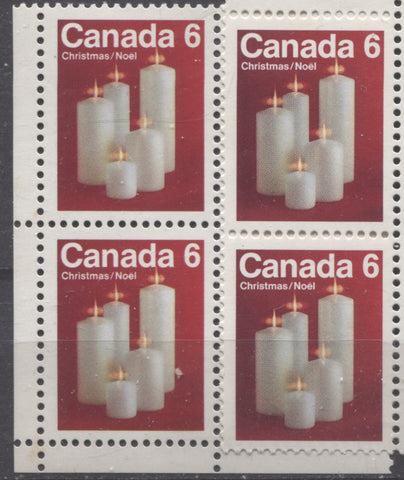
This picture shows a lower left field stock block, with the left pair of another block placed over the top. If you compare the right and left vertical pairs you can see that the right one is noticeably darker than the one of the left. If you look under magnification, you can see that this is because there are many more fine dots of black colour in the background of the right pair than there are on the left block.
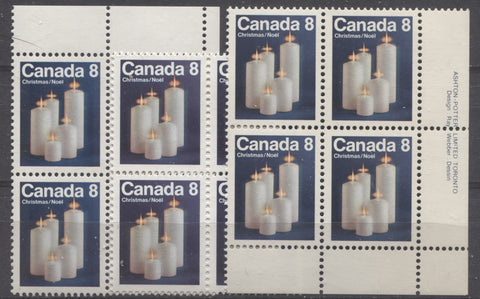
Here we have three shades of the 8c. The normal darker blue with a hint of violet is seen in the centre vertical pair. If you compare this to the two pairs on either side, you can see that the other two pairs are printed in a blue that is somewhat greenish by comparison. Finally, if you compare the left and right vertical pairs carefully, you can see that the left pair is printed in a slightly brighter blue than the block on the right.

Here are two distinct shades of the 10c. The block on the left is printed in a deep yellow green, while the block on the right is a more bronze green shade.
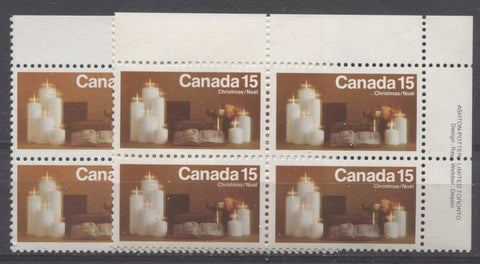
Finally, we have two shades of the 15c, yellow bistre, showing the normal dark shade on the right, and a much lighter shade on the left.
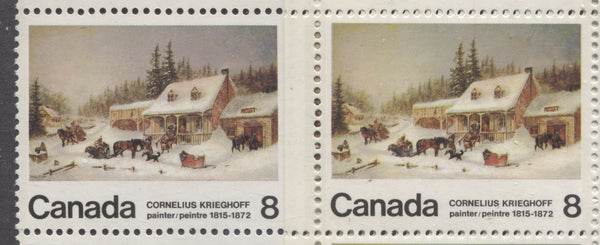
On the Krieghoff stamp the difference in shade is harder to describe. The difference lies mainly in the appearance of the sky, which appears to contain more yellow and less greyish blue.
Gum Varieties
The gum used on these issues is remarkably uniform. It is a very light cream coloured, and smooth PVA gum that has a satin sheen. I have not found any significant variations in the gum on these three issues.
Perforations
All of the stamps from these issues are comb perforated and they are found with found with four different guages:
- 12.0, which is found on the Earth Sciences Issue.
- 12.5 x 12, which is found on the 6c and 8c values of the Christmas issue.
- 11.0 x 10.8, which is found on the 10c and 15c values of the Christmas Issue.
- 12.5, which is found on the Cornelius Krieghoff Issue.
I have not found any variation in the measurements of these gauges. However, there are differences in the configuration of the perforations on the sheets, as well as differences in the size of the perforation holes.
Configuration of the Perforations
The sheets of the Earth Sciences and Krieghoff issues had selvage that was perforated through on both sides. However, the Christmas issue is found with the left selvage imperforate on philatelic stock and with perforated left selvage on field stock. In all cases, the right selvage, bottom selvage and top selvage is imperforate. The picture below shows these differences on two blocks of the 6c Christmas stamp:
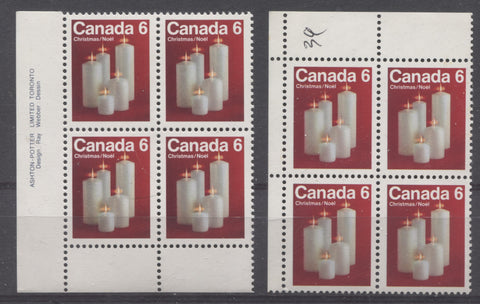
Note how the horizontal perforations on the left block do not extend into the left selvage, whereas they do on the right block.
The Size of the Holes
I have noticed that on the 6c and 8c Christmas stamps and the Krieghoff stamps, there are differences in the size of the perforation holes. Normally the holes are as wide as the perforation tips that separate them, so that the perforation tips are not sharp. However, some examples show holes that are very clearly wider than the perforation tips, which causes the perforation tips themselves to appear quite sharp. These differences are shown on the two 6c Christmas stamp blocks below:
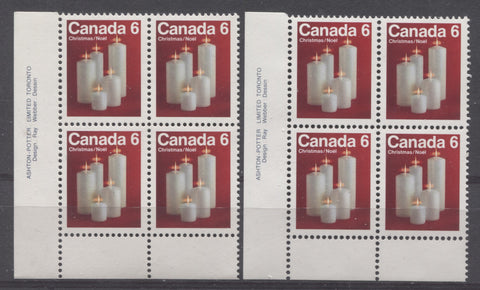
If you look closely at these two inscription blocks and compare the perforations, you can see that the holes on the right block are very slightly larger than the left block, and that consequently the perforation tips are sharper.
Winnipeg Tagging
The Christmas issue is the very last issue to exist with Winnipeg tagging. Only the Winnipeg tagging found on these stamps is quite unlike any of the examples that preceded it. For starters it is almost completely colourless, does not glow under UV and can only really be seen by tilting the stamp to a light source and seeing a band that appears duller than the rest of the stamp as shown below:
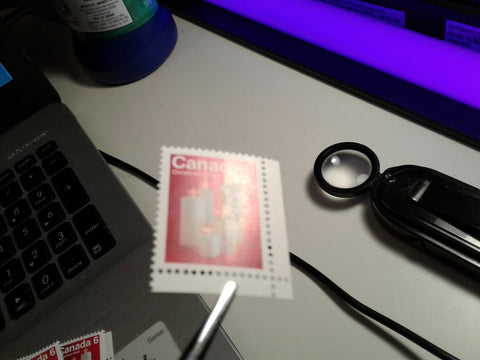
In this picture, which is somewhat out of focus you can see a dull 4 mm wide band running down the centre of the stamp. This is the Winnipeg centre bar.
The 6c was tagged with 4 mm bands that ran down the centre of stamps and were spaced 20 mm apart in the horizontal direction. On the 6c, the bands appear to not extend past the printed design and into the margins. However, if you hold a corner block up at an angle to the light, you can see that the bands do extend slightly into the top and bottom selvage.
The 8c, 10c and 15c values were tagged with 8 mm bands that were applied down the vertical perforations. The bands applied at the sides of the sheets were only 6 mm wide, rather than 8 mm everywhere else on the sheets. On the 8c value, they are spaced 16 mm apart in the horizontal direction.
Ottawa Tagging
All three of these issues exist with 3 mm OP-2 Ottawa tagging. The tagging is just visible in normal light, as thin bands at the sides of the stamps, along the perforations that stop just beyond the margins of the stamps, protruding just slightly into the selvage. Under UV, the colour varies from a deeper greenish yellow, to a slightly lighter, brighter greenish yellow, as shown in the picture below:
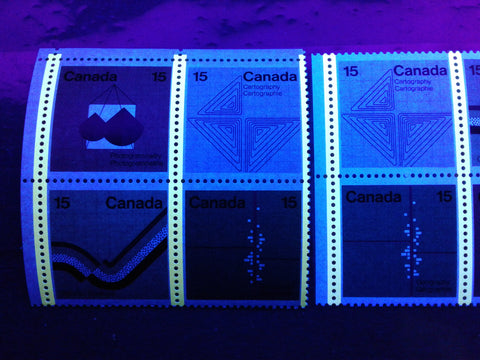
The block on the left has the slightly deeper coloured bands than the one on the right. The difference is difficult to see in the picture, but can be seen if you closely compare the two bands at the extreme left of each block.
The spacing between the tagging bars on the Earth Sciences stamps is 27 mm in the horizontal direction. On the 6c and 8c Christmas stamps it is 20.5 mm. The spacing on the 10c and 15c Christmas stamps is 32 mm. Finally, the spacing on the Krieghoff stamp is 37 mm.
Rose lists both the 6c and 8c values as existing with a single wide tagging bar at the left of the stamps, while the Krieghoff issue is known with a single tagging bar down the centre.
Constant Varieties
The only stamp in this group to exhibit any constant varieties is the Krieghoff stamp, and it is a real happy hunting ground for varieties. According to Unitrade there are at least 24 constant varieties on this stamp, but Unitrade only lists five of these. It would be easy to look at the Unitrade listings and think that these varieties must be common. However, this is not the case at all, except for the "broken door frame" variety, which occurs on every stamp from column 4 of every sheet. or 20% of all the stamps printed.
Many of the listed flaws and all 19 of the unlisted ones occur on only 1 position of one pane. Given that the press sheet layout was 200 stamps, divided into 4 panes of 50, this means that many of these varieties will only be found once on every 200 stamps, which is reasonably scarce. When you combine this with the inherent scarcity of the tagged stamps, getting examples of all 24 varieties can be quite challenging indeed.
Let's start with the five that are listed in Unitrade:
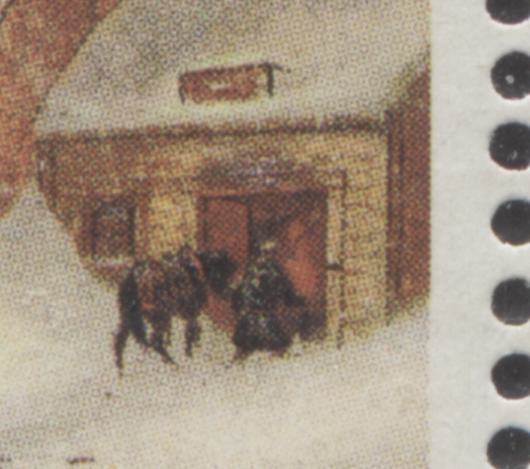
The first of these is the broken door frame, shown above, which appears as a dash in the middle of the right beam of the door frame. It is, as I said above, the most common of the varieties found on this stamp.
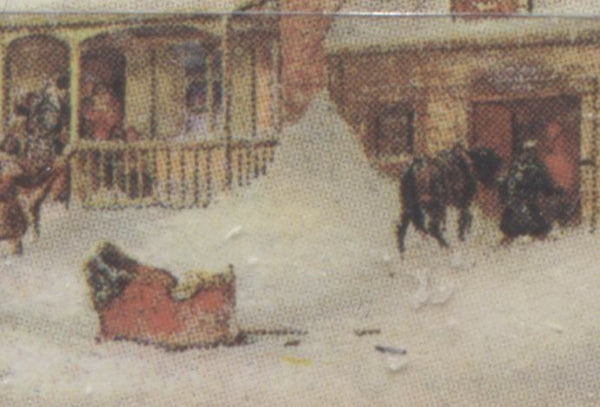
The next variety is the "extra log in snow". It is the large black dash that is just below and forward of the two smaller logs that are in front of the sleigh. This comes from position 39 only of the second pane.
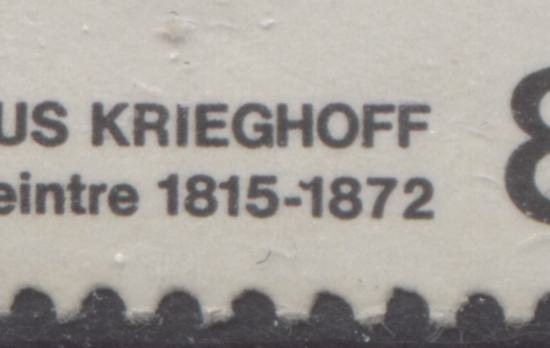
The third listed variety is the "extended 1". If you look at the "1" of "1872" you can see that the upper serif is much longer than the "1"'s on "1815". This occurs only on position 14 of the second pane as well.
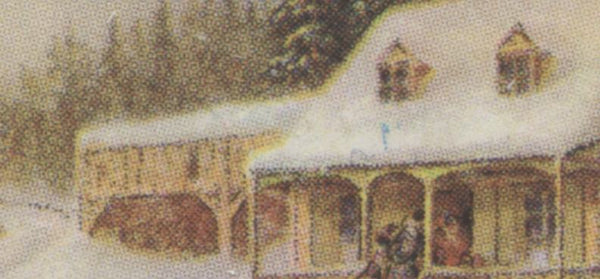
The fourth listed variety is known as the "Icicle on Roof", and is shown above, as the blue lines below the left gable on the roof. This is also a variety from pane 2, and only occurs on position 45.

The last of the listed varieties is called the "branch below sleigh" and is the large diagonal slash that can be seen right below the middle of the sleigh. This comes only from position 50 of pane 1.
Now, I will illustrate some of the other 19 constant varieties that occur on each of the four panes. I don't have examples of all of them, and I do not know what some of them are. However, as I become aware of additional varieties and have examples to illustrate, I will add them by way of an update to this post.

This is the "rock below sleigh". This comes from position 28 of pane 1.

This next variety is called the "hole in the roof", and is the black dot that appears between the two gables. This comes from position 2 of pane 1.

This variety is called the "extra footprint and blue ice under sleigh". There is a small blue dot just to the lower right of the sleigh and a black dot in the snow near the man. According to the article I was researching this is supposed to come from position 14 of pane 1. However, the example here comes from an upper right field stock block, so position 5. It may be a variant of the position 14 variety.
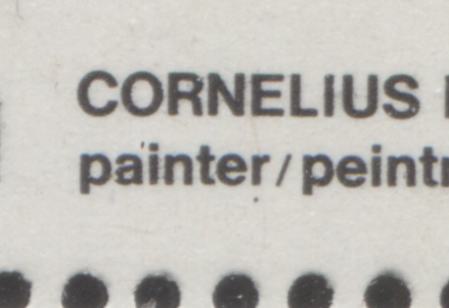
This variety is the "dot below r of painter". This example is position 2 on an upper left field stock block. This is not listed in the article I was reading as constant, but I have found it on more than 1 upper left block. This comes from pane 1.
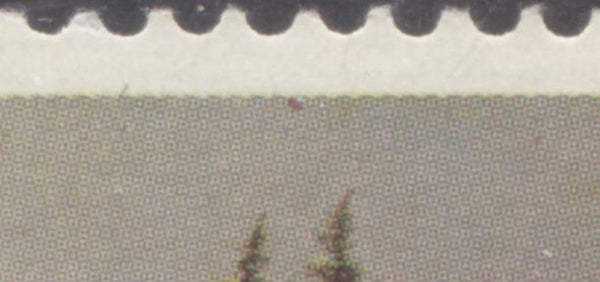
This "red dot above the trees" variety occurs on one of the right hand stamps in a pane. From the article I was researching it is most likely position 15 of pane 4.
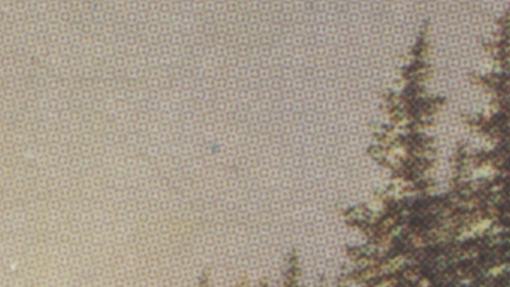
This "blue dot above the trees" comes from position 35 of pane 3.
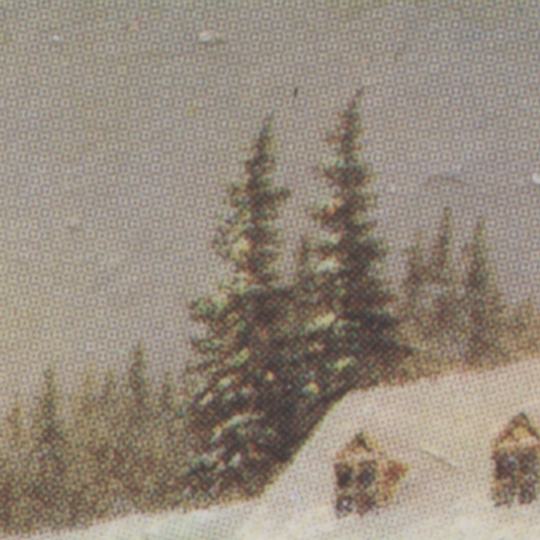
This one is the "bird between trees" variety. It occurs on position 48 of pane 1.
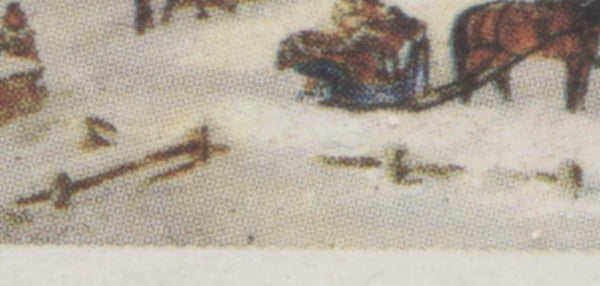
This variety is called the "rock in snow", and is the black dot at the base of the design in the centre of the gap between the fences. The article I have been reading says that it is from position 1 of upper right corner blocks, of pane 3. However, all three examples that I have are all position 1 of upper left corner blocks, so position 1 of pane 3.
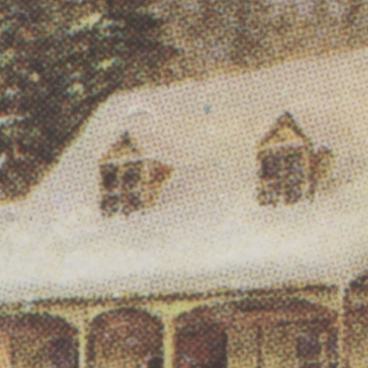
This is the last variety that I have to illustrate at this time. This is the "blue ice on roof" and occurs at position 45 of pane 4.
So, in addition to the five listed varieties, I have illustrated 9 of the remaining 19 varieties. I will add the other 10 as I learn where they are and how to identify them.
Corner Blocks
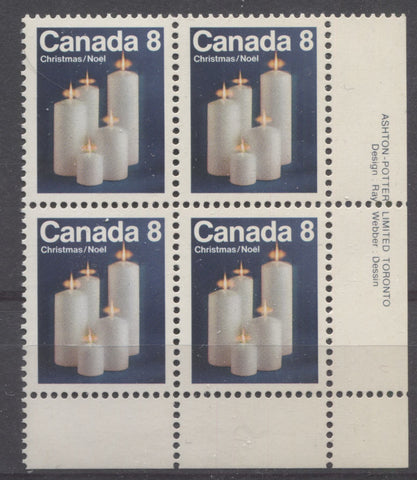
The corner blocks for these stamps are rather straightforward as there were no plate numbers. However, as stated before, both philatelic and field stock blocks can be collected, and because the panes were made by guillotining larger sheets, up to 12 different positions of these can be found for each issue, except for the Earth Sciences Issue. In addition, you can collect all the paper, perforation and fluorescence varieties, so that a complete collection of blocks will be quite a bit larger than would first appear to be the case.
Errors
There are three major errors that Unitrade either lists or mentions from these issues. The first of these are the interpanneau gutter pairs of the Earth Sciences Issue. These are horizontal pairs of two different stamps that are separated by a stamp sized blank gutter in the middle. These result from the failure of the guillotine that would normally separate the miniature sheets of 16, from separating two adjacent sheets. According to Unitrade only 8 pairs are known, 5 of which are defective.
The second and third errors are both colour omitted errors that occur on the Christmas issue, due to replellex errors. One is the missing red on the 8c, in which the flames are missing the red colour, and the background appears light blue, instead of the usual violet blue. The third error is the missing yellow on the 10c, which is known to exist in a vertical strip of 4.
First Day Covers
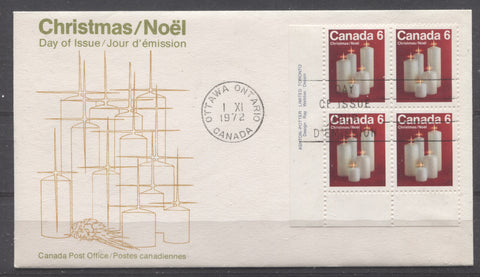
By the end of 1972 the Official Canada Post first day covers, such as the one shown above for the 6c Christmas issue are the norm, and are what one usually finds in collections containing first day covers. The covers are usually found with singles, pairs, blocks, inscription blocks and entire sets. On all the issues, all the mentioned configurations are found tagged and untagged also.
However, there are still a few private Cachet covers that can be found also, such as the Rose Craft cover of the 1972 Earth Sciences Issue, shown below:
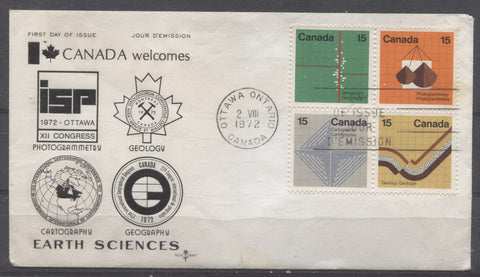
Postal History and Cancellations

This group of issues contains a good number of higher value stamps that are difficult to find on cover, and thus provides some challenge to the postal historian. Only two of the stamps, being the 8c Christmas and the Krieghoff stamp correspond to the standard, common, first class rate. All the others are either the 6c denomination, which was for third class mail only, the 10c, which was the rate the the U.S, and the 15c, which was the international rate for the first ounce.
Despite the fact that these rates are quite routine, it is difficult to find usages of the 10c and 15c Christmas and the Earth Sciences Issue on cover. The above cover is a nice example of a double weight airmail cover to Denmark. The 30c rate has been paid with two stamps from the series. A real challenge is also to look for the tagged stamps commercially used on cover, especially mixed frankings of the Winnipeg and Ottawa tagged stamps.
All of these stamps are also larger than the small size definitives, and consequently they tend to show cancellations quite well. So, some challenging fun can be had trying to see how many different CDS cancellations you can find on these stamps, especially the 10c and 15c stamps, as well as the tagged examples.
This concludes my exploration of these three issues. Next week, I will begin my long series of posts about the 1972-1978 Caricature and Landscape Definitive Issue.

